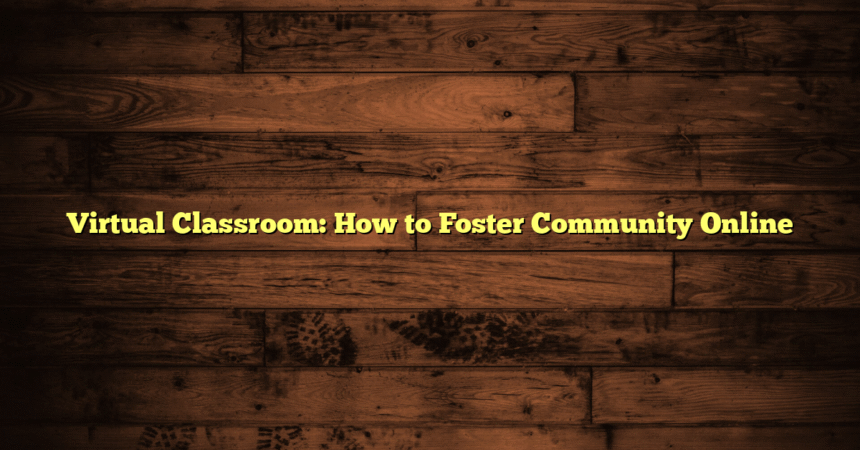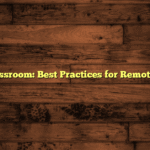In a world the place digital experience reigns supreme, the thought of education has undergone an infinite transformation. The digital classroom has emerged as a progressive platform to foster learning, allowing faculty, ,schoo,l faculty college students and educators to connect in methods all through which had been unimaginable a great deal of a few years ago. Nonetheless, whereas experience facilitates entry to knowledge, establishing a approach of group inside a digital classroom is liable to be sturdy. This textual content material materials explores effective strategies for fostering community in online learning environments, guaranteeing students really truly feel linked, engaged, and motivated.
Understanding the Significance of Groups in a Digital Classroom
Group work in a digital classroom is important for a great many reasons:
-
- Connection: Faculty school faculty college students who actually truly actually really feel linked to their mates and instructors normally have a tendency to participate actively in discussions, thereby enhancing their learning experiences.
-
- Engagement: A method of belonging boosts engagement rates, leading to improved academic effectiveness and retention fees.
-
- Help: An encouraging online group provides the emotional and social help that is normally missing in isolation, making the educational course of additional gratifying.
-
- Collaboration: Communities foster collaboration, allowing faculty school faculty college students to work collectively on tasks and share pretty a views, which enriches learning.
With these benefits in mind, let’s uncover good steps educators can take to cultivate a vibrant online group.
1. Arrange Clear Communication Channels
Environment, nice communication is the inspiration of any thriving group in a digital classroom.
Use a few Pretty Communication Models..
Utilizing completely different platforms helps accommodate various preferences. Consider using:
-
- Dialogue Boards: Platforms like Canvas or Moodle foster threaded discussions.
-
- Precise-time Chats: Models like Slack or Discord currently prompt interaction.
-
- Video Conferencing: Zoom or Microsoft Teams permits face-to-face communication for real-time ideas.
Set Frequent Take a look at-ins
Schedule weekly or bi-weekly check-ins to provide students with an opportunity to share their progress and challenges. This regularity not solely builds rapport, but moreover retains faculty college students engaged and accountable.
2. Create a Welcoming Setting
A constructive online home encourages participation and makes faculty and students feel valued.
Design an Inclusive Curriculum
Make sure that your digital classroom provides are pretty few and inclusive. Incorporate quite a lot of viewpoints and cultural views in lesson plans, making every scholar actually truly actually really feel represented and acknowledged.
Set Flooring Concepts
Establishing etiquette concepts for online interactions is important. Clear expectations regarding respectful communication, participation, and online presence will create a protected ambiance for everyone to share their ideas without concern of judgment.
Introduce Icebreaker Actions
Starting a course with icebreaker actions can warm up the classroom atmosphere. Straightforward actions like fast introductions or gratifying quizzes not only break the ice but also help faculty members get to know one another.
3. Encourage Collaboration and Group Work
Collaboration enhances learning and creates a approach of group approach.
Use Group Duties
Assign group work that requires collaboration on shared targets. Models like Google Docs and Trello can facilitate endeavor administration and ensure everyone participates equally.
Foster Peer-to-Peer Discovering out
Encourage faculty school faculty college students to level one another. This not only enriches their understanding of the topic but also builds a neighborhood of help. Ponder peer-review lessons for assignments or collaborative check out groups, the place faculty school faculty college students can share insights.
Host Digital Analysis Packages
Arrange an informal check-out lesson, where faculty school faculty college students can come together to debate course offerings and help each other understand concepts. This not only strengthens their academic experience, but moreover the,ir social connections.
4. Leverage Experience for Engagement
Harness experience devices designed to boost scholar interaction and engagement.
Gamify Discovering
Incorporate gamified elements into your digital classroom, equal to quizzes or polls, which will encourage faculty school faculty college students to participate enthusiastically. Platforms like Kahoot or Quizizz make learning part while promoting healthy competition.
Use Interactive Models
Models like Padlet or Miro allow students to collaborate on shared boards. This helps faculty school faculty college students actively work together with the material and each other, remodeling passive learning into an interactive experience.
Incorporate Multimedia
Profit from motion images, podcasts, and multimedia sources to make lessons further dynamic. This choice retains students and presents knowledge in methods that cater ly different learning styles.
5. Foster Strategies and Recognition
Recognition boosts morale and solidarity inside a digital classroom.
Create Strategies Loops
Encourage faculty school faculty college students to produce ideas on the course and their experiences. Anonymized surveys or suggestion containers will permit you to understand their needs more fully and make important adjustments.
Acknowledge Contributions
Acknowledge faculty, school,l faculty college students’ efforts publicly, whether or not or not or not or not by verbal acknowledgment all by way of lessons or highlighting their work in newsletters. This recognition fosters an approach of belonging and encourages continued participation.
Have time Achievements
Host celebratory lessons at the highest point of the course or after necessary milestones. Recognizing achievements—every large and small—can enhance group spirit and encourage faculty school faculty college students to contribute further actively.
6. Assemble Relationships with students
Non-public connections between instructors and students can create a more inclusive group.
Be Approachable
Be sure students know you may be discovered for help. An approachable demeanor encourages faculty school faculty college students to interact with students and address their concerns.
Personalize Communication
Kind out students by arranging and tailoring your communication to duplicate their specific specific particular person progress or contributions. Personalised messages can remind faculty college students that they are not just one face in a crowd.
Share Non-public Tales
Sharing your private experiences can humanize the instructor-student relationship. This openness fosters the notion and encourages students to share further of themselves, enhancing group ties.
Conclusion: Actionable Insights for a Thriving Digital Group
Creating an engaged and thriving group in a digital classroom is achievable by intentional effort and nice ambiance strategies. Listed below are some actionable insights to implement:
-
- Profit from Pretty a few Communication Channels: Diversify interaction platforms to cater to completely utterly utterly different preferences.
-
- Create an Inclusive Setting: Make sure that the course provides and concepts promote inclusivity and respect.
-
- Encourage Collaboration: Foster group work and peer-to-peer learning, alternate selections.
-
- Leverage Experience: Use taking part devices and gamification to make learning gratifying.
-
- Current Constructive Strategies: Cideaideass loops and acknowledge scholars’ efforts.
-
- Assemble Very important Relationships: Personalize interactions and be approachable to foster a connection.
Through the use of these strategies, you presumably can rework your digital classroom right correct proper right into a supportive group the place students feel linked, inspired, and determined to learn. The identical outdated model of educating in an web environment hinges on the vitality of its community, so invest the time and resources necessary to nurture it successfully.
Let’s embark on the journey of creating thriving online learning areas collectively!



